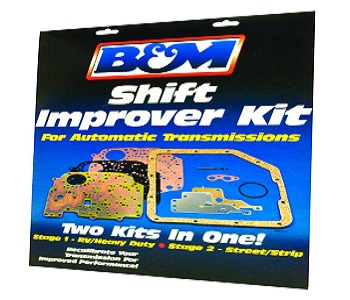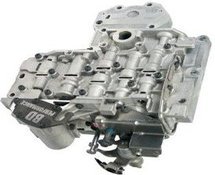Transmission Valve Body Improvement

The transmission valve body is one of the most important components in the entire transmission assembly. It can be compared to the circulatory system of the human body. This also happens to be the component where my experience and interest first developed. As a kid my first car was a 74 Dodge Charger with a Chrysler 904 automatic unit.
All my friends that are in to racing purchased B&M shift kits to increase the shifting performance. People who installed these kits would often get such an extremely hard shift at wide open throttle that the tire would chirp between first and second gear when shifting. The second gear chirp was very cool back in my day.
So I purchased one of these B&M shift kits which modified the fluid flow and control of the transmission valve body. It did this by providing a new separator plate that divided the sections of the valve body.
Also included were all the gaskets, some replacement springs, o-ring seals and a new spool valve. Keep in mind that each kit is designed for that particular automatic transmission and may include more or even less stuff inside.
The most important thing it provided was the instructions. This was detailed step by step guide with helpful pictures on which check balls to remove. As well as where the replacement springs and check balls needed to be installed.
The end result was that my transmission when it shifted from first to second gear would just about break your neck at the wide-open throttle position. And yes both of my giant L-60 tires would chirp since I had a 3:55 Positraction rear differential installed. Note the shift was always firm but much gentler at part throttle so it was not uncomfortable to drive in.
How Transmission Valve Bodies Work

For the proper operation key internal components such as the bands and disc packs must be applied and released at the proper time. It is the valve body assembly that’s responsible for the hydraulic control of pressurized fluid throughout the entire transmission. You might even call it the hydraulic brains of the operation.
The main parts that are included in this component are the valve body itself containing the hydraulic passageways, a separator plate and the transfer plate or housing. Inside the housing you’ll find spool valves, check balls and poppet valves. All of these items are responsible for either stopping or directing automatic transmission fluid flow.
These parts are then all bolted together as a single unit and mounted to the case housing so that the hydraulic passageways match-up with the internal passageways of the case assembly. It is the valve body’s job to sense and respond to the drivers needs at the same time that it is determining engine speed and vehicle load.
The idea is that the vehicle will remain in a lower gear when additional power is required due to pulling heavy loads or even going up a steep hill. If the transmission was to try these operations in its highest gear ratio the engine would struggle and possibly stall.
On modern vehicles the valve body internal components are controlled by electrical solenoids. These electronic devises open or close to allow fluid to flow in a particular direction as required by the circumstances that the vehicle is operating under. As an example if you are cruising in the highest gear range and you slam the gas pedal to the floor which some would call a passing gear the fluid pressure will increase and be directed to overcome the pressure of the proper shift valve. This can apply the next gear down and hold it applied until the engine’s maximum RPM is reached.
Transmission Products and Resources
The transmission section of the you fix cars website provides more information about both theory and operation. This next link takes you there from this page about the automatic transmission valve body.
The homepage is a great place to go to see what else is available here on this automotive website. You can also find out how and where to ask DIY auto repair questions.

